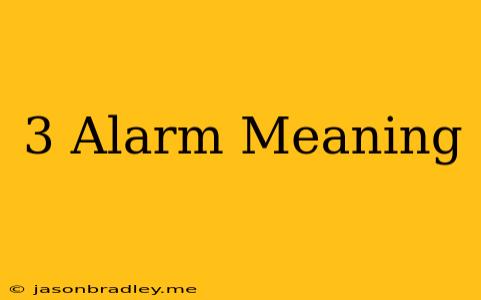What Does a 3-Alarm Fire Mean?
The term "3-alarm fire" is a common phrase used to describe a large and serious fire that requires a significant response from the fire department. It doesn't literally mean that three alarms have been sounded, but rather that the fire is so intense that it needs multiple fire crews and resources to contain it.
Understanding Fire Alarms
Fire alarms are a crucial part of emergency response systems. When a fire is reported, the fire department dispatches fire crews and equipment based on the severity of the situation. This is where the alarm system comes in:
- 1-alarm fire: This is a standard response for a relatively small fire that can be handled by a single fire crew.
- 2-alarm fire: This means a larger fire requiring additional manpower and resources. It could involve multiple fire engines, ladder trucks, and additional personnel.
- 3-alarm fire: A 3-alarm fire signifies a major incident requiring a significant deployment of resources. This could include multiple fire stations, specialized equipment like aerial ladders and hazmat teams, and potentially support from neighboring fire departments.
Factors Determining a 3-Alarm Fire
Several factors contribute to a fire being classified as a 3-alarm event:
- Size and intensity of the fire: A large and fast-spreading fire that threatens multiple structures or a significant area would likely require a 3-alarm response.
- Location and accessibility: Fires in densely populated areas, buildings with complex layouts, or difficult-to-access locations might need a 3-alarm response to ensure efficient firefighting.
- Presence of hazardous materials: If the fire involves hazardous chemicals or materials, the fire department will likely increase the alarm level to ensure the safety of firefighters and the public.
- Potential for escalation: If the fire shows signs of rapid spread or a significant risk of spreading to nearby buildings, a 3-alarm response is warranted.
Importance of 3-Alarm Response
The 3-alarm response ensures that enough resources are available to:
- Contain and extinguish the fire: More firefighters and equipment mean faster and more efficient firefighting operations.
- Protect nearby structures: A larger force can establish a perimeter and prevent the fire from spreading to adjacent buildings.
- Ensure public safety: Increased manpower allows for better control of the situation and the evacuation of nearby residents.
While the term "3-alarm fire" might sound dramatic, it's important to remember that the fire department's primary concern is public safety. A 3-alarm response is a sign that a serious incident is unfolding, and the fire department is taking every necessary step to protect lives and property.
